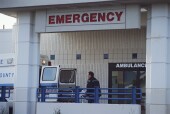
MONDAY, Nov. 22 (HealthDay News) — Risk of bleeding for patients on antiplatelet therapy with either warfarin or a combination of Plavix (clopidogrel) and aspirin is substantial, a new study finds.
Both therapies are prescribed for millions of Americans to prevent life-threatening blood clots, especially after a heart attack or stroke. But the Plavix-aspirin combination was thought to cause less bleeding than it actually does, the researchers say.
“As with all drugs, these drugs come with risks; the most serious is bleeding,” said lead author Dr. Nadine Shehab, from the U.S. Centers for Disease Control and Prevention (CDC).
While the risk of bleeding from warfarin is well-known, the risks associated with dual therapy were not well understood, she noted.
“We found that the risk for hemorrhage was threefold higher for warfarin than for dual antiplatelet therapy,” Shehab said. “We expected that because warfarin is prescribed much more frequently than dual antiplatelet therapy.”
However, when the researchers took the number of prescriptions into account, the gap between warfarin and dual antiplatelet therapy shrank, Shehab said. “And this was worrisome,” she added.
For both regimens, the number of hospital admissions because of bleeding was similar. And bleeding-related visits to emergency department visits were only 50 percent lower for those on dual antiplatelet therapy compared with warfarin, Shehab explained.
“This isn’t as big a difference as we had thought,” she said.
For the study, published Monday in the Archives of Internal Medicine, Shehab’s team used national databases to identify emergency department visits for bleeding caused by either dual antiplatelet therapy or warfarin between 2006 and 2008.
The investigators found 384 annual emergency department visits for bleeding among patients taking dual antiplatelet therapy and 2,926 annual visits for those taking warfarin.
Among those taking Plavix and aspirin, about 60 percent of the visits were for nosebleeds or other minor bleeds. The rate of emergency department visits was 1.2 for every 1,000 prescriptions for dual antiplatelet therapy, compared with 2.5 for every 1,000 prescriptions for warfarin, the researchers found.
“There is an inclination in the clinical community to treat the hemorrhagic risk of dual antiplatelet therapy a little bit less seriously than [the risk for] warfarin,” Shehab said. “We hope by shedding some light on the burden and the nature of the bleeding risks of dual antiplatelet therapy that providers will take the risk seriously,” she added.
Moreover, doctors should inform their patients of the risks for small bleeds associated with dual antiplatelet therapy, she noted.
Shehab cautioned that this study is not designed to recommend one therapy over another, but only to assess the problem of bleeding for dual antiplatelet therapy.
Dr. Gregg Fonarow, American Heart Association spokesman and professor of cardiology at the University of California, Los Angeles, said that “the use of dual antiplatelet therapy with aspirin and clopidogrel significantly reduces the risk of cardiovascular events in patients after acute coronary syndromes and patients undergoing coronary stenting.”
There is a well-defined increased risk of major and minor bleeding with dual antiplatelet therapy, but in most patients the benefits of therapy outweigh these risks, he said.
“These findings reinforce the need for patients receiving dual antiplatelet therapy to be well-educated on the benefits of treatment and the importance of adherence, but also the increased risk of major and minor bleeding,” Fonarow said.
More information
For more information on antiplatelet therapy, visit the American Heart Association.

